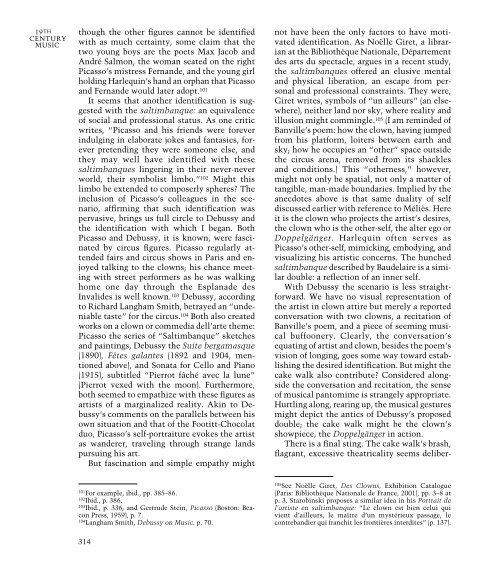Parisian Cake Walks.pdf - ResearchSpace@Auckland
Parisian Cake Walks.pdf - ResearchSpace@Auckland
Parisian Cake Walks.pdf - ResearchSpace@Auckland
You also want an ePaper? Increase the reach of your titles
YUMPU automatically turns print PDFs into web optimized ePapers that Google loves.
19TH<br />
CENTURY<br />
MUSIC<br />
though the other figures cannot be identified<br />
with as much certainty, some claim that the<br />
two young boys are the poets Max Jacob and<br />
André Salmon, the woman seated on the right<br />
Picasso’s mistress Fernande, and the young girl<br />
holding Harlequin’s hand an orphan that Picasso<br />
and Fernande would later adopt. 101<br />
It seems that another identification is suggested<br />
with the saltimbanque: an equivalence<br />
of social and professional status. As one critic<br />
writes, “Picasso and his friends were forever<br />
indulging in elaborate jokes and fantasies, forever<br />
pretending they were someone else, and<br />
they may well have identified with these<br />
saltimbanques lingering in their never-never<br />
world, their symbolist limbo.” 102 Might this<br />
limbo be extended to composerly spheres? The<br />
inclusion of Picasso’s colleagues in the scenario,<br />
affirming that such identification was<br />
pervasive, brings us full circle to Debussy and<br />
the identification with which I began. Both<br />
Picasso and Debussy, it is known, were fascinated<br />
by circus figures. Picasso regularly attended<br />
fairs and circus shows in Paris and enjoyed<br />
talking to the clowns; his chance meeting<br />
with street performers as he was walking<br />
home one day through the Esplanade des<br />
Invalides is well known. 103 Debussy, according<br />
to Richard Langham Smith, betrayed an “undeniable<br />
taste” for the circus. 104 Both also created<br />
works on a clown or commedia dell’arte theme:<br />
Picasso the series of “Saltimbanque” sketches<br />
and paintings, Debussy the Suite bergamasque<br />
(1890), Fêtes galantes (1892 and 1904, mentioned<br />
above), and Sonata for Cello and Piano<br />
(1915), subtitled “Pierrot fâché avec la lune”<br />
(Pierrot vexed with the moon). Furthermore,<br />
both seemed to empathize with these figures as<br />
artists of a marginalized reality. Akin to Debussy’s<br />
comments on the parallels between his<br />
own situation and that of the Footitt-Chocolat<br />
duo, Picasso’s self-portraiture evokes the artist<br />
as wanderer, traveling through strange lands<br />
pursuing his art.<br />
But fascination and simple empathy might<br />
101 For example, ibid., pp. 385–86.<br />
102 Ibid., p. 386.<br />
103 Ibid., p. 336; and Gertrude Stein, Picasso (Boston: Beacon<br />
Press, 1959), p. 7.<br />
104 Langham Smith, Debussy on Music, p. 70.<br />
314<br />
not have been the only factors to have motivated<br />
identification. As Noëlle Giret, a librarian<br />
at the Bibliothèque Nationale, Département<br />
des arts du spectacle, argues in a recent study,<br />
the saltimbanques offered an elusive mental<br />
and physical liberation, an escape from personal<br />
and professional constraints. They were,<br />
Giret writes, symbols of “un ailleurs” (an elsewhere),<br />
neither land nor sky, where reality and<br />
illusion might commingle. 105 (I am reminded of<br />
Banville’s poem: how the clown, having jumped<br />
from his platform, loiters between earth and<br />
sky; how he occupies an “other” space outside<br />
the circus arena, removed from its shackles<br />
and conditions.) This “otherness,” however,<br />
might not only be spatial, not only a matter of<br />
tangible, man-made boundaries. Implied by the<br />
anecdotes above is that same duality of self<br />
discussed earlier with reference to Méliès. Here<br />
it is the clown who projects the artist’s desires,<br />
the clown who is the other-self, the alter ego or<br />
Doppelgänger. Harlequin often serves as<br />
Picasso’s other-self, mimicking, embodying, and<br />
visualizing his artistic concerns. The hunched<br />
saltimbanque described by Baudelaire is a similar<br />
double: a reflection of an inner self.<br />
With Debussy the scenario is less straightforward.<br />
We have no visual representation of<br />
the artist in clown attire but merely a reported<br />
conversation with two clowns, a recitation of<br />
Banville’s poem, and a piece of seeming musical<br />
buffoonery. Clearly, the conversation’s<br />
equating of artist and clown, besides the poem’s<br />
vision of longing, goes some way toward establishing<br />
the desired identification. But might the<br />
cake walk also contribute? Considered alongside<br />
the conversation and recitation, the sense<br />
of musical pantomime is strangely appropriate.<br />
Hurtling along, rearing up, the musical gestures<br />
might depict the antics of Debussy’s proposed<br />
double; the cake walk might be the clown’s<br />
showpiece, the Doppelgänger in action.<br />
There is a final sting. The cake walk’s brash,<br />
flagrant, excessive theatricality seems deliber-<br />
105 See Noëlle Giret, Des Clowns, Exhibition Catalogue<br />
(Paris: Bibliothèque Nationale de France, 2001), pp. 3–8 at<br />
p. 3. Starobinski proposes a similar idea in his Portrait de<br />
l’artiste en saltimbanque: “Le clown est bien celui qui<br />
vient d’ailleurs, le maître d’un mystérieux passage, le<br />
contrebandier qui franchit les frontières interdites” (p. 137).















